Forward-control Fastrac ups spreading output by 30%
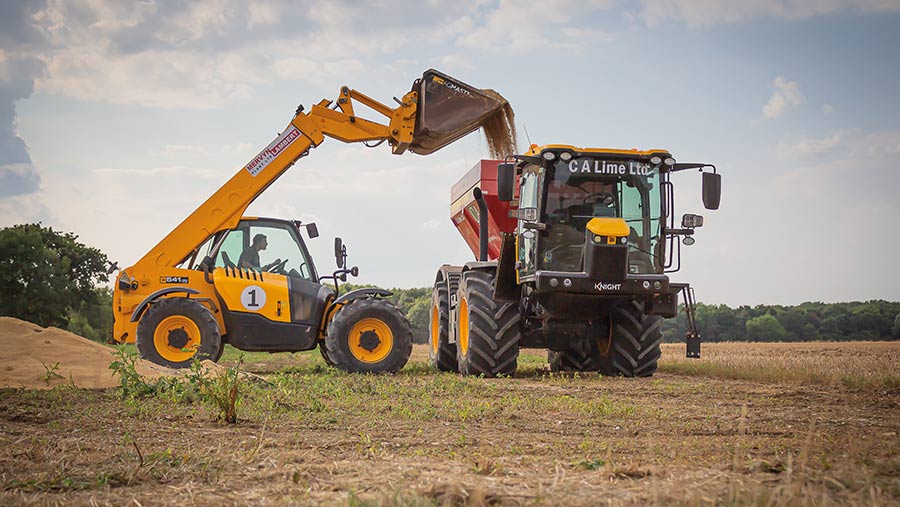 © Martin Murphy
© Martin Murphy Spreading 30,000t of lime annually across a 70-mile radius means Chris Anstey’s supply-and-apply business needs an applicator that is quick, versatile, reliable and comfortable.
Those qualities were somewhat lacking in his ageing pair of Multidrive tractor units, which were beginning to show signs of frailty as they traipsed across the countryside, eastwards from Towcester and Milton Keynes to Essex, Suffolk and Norfolk.
“The Multidrives and Bredal spreader bodies were ideal when I decided to do my own lime applications in 2014 – they were reasonably priced, solidly made and mechanically simple. Being self-propelled also meant they could tow a low-loader with a pickup and telehandler on board, allowing them to stay away from the yard for several months at a time.”
See also: On test: JCB Fastrac 4220
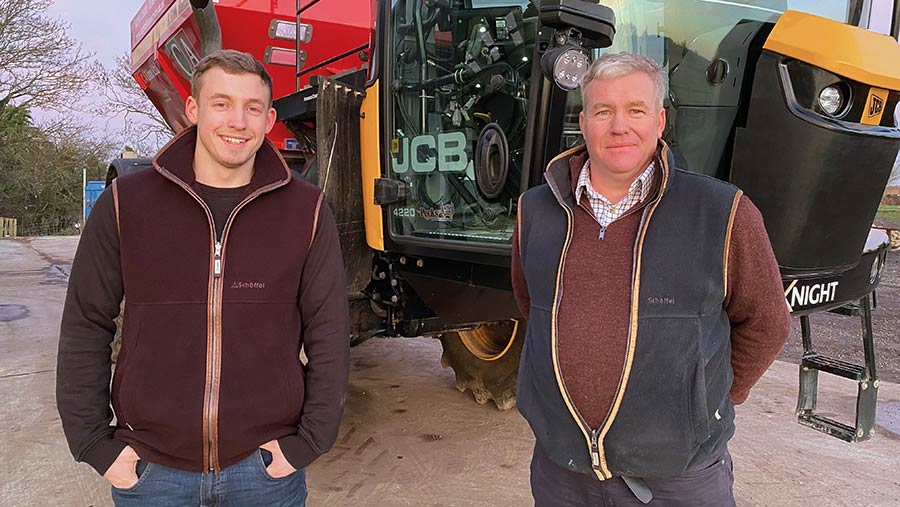
Chris Anstey and his son, Ryan © MAG/Oliver Mark
However, by the start of last year the older of the pair, a 6195, had clocked more than 10,000 hours. “We were sleep-walking towards a problem,” says Mr Anstey.
“We didn’t have a local dealer, I wasn’t sure whether Alamo was going to continue building them, and the transmission wasn’t going to last forever – and we can’t afford to risk any extended periods of downtime when our main season is so short and intense.”
He started sizing up replacements, but it didn’t take long to realise that the options for a four-wheel spreader without a half-a-million-pound price tag were limited.
JCB Fastrac 4220 with Knight forward-control conversion
- Engine Six-cylinder, 6.6-litre Agco Power
- Rated power 217hp@2,100rpm
- Max power 235hp@1,900rpm
- Max torque 700Nm@1,500rpm
- Transmission Agco ML180 two-range CVT
- Top speed 63kph
- Weight 8t tractor, 2t hopper plus subframe
- Hydraulics 195 litres/min
“The Unimog didn’t have the carrying capacity, Ryetec’s MAN truck conversion is more lorry and less tractor, and the Ploeger was too big, too expensive and couldn’t tow the flatbed trailers to make it a self-sufficient outfit.
A three-wheeler was out of the question too, as it would rule out any row crop work.”
The one machine that could potentially meet all his criteria was the JCB Fastrac.
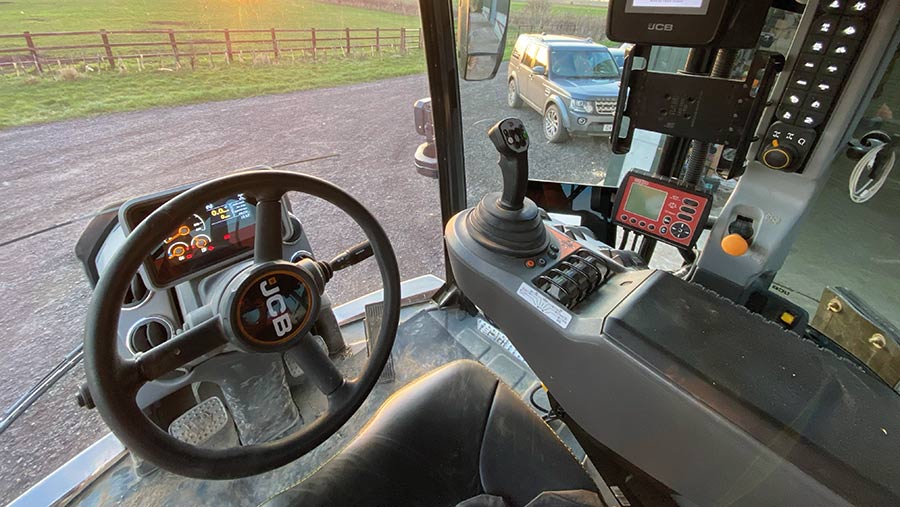
© MAG/Oliver Mark
Not only could he source it through his local dealer, Pecks at Ramsey St Mary’s, but it would give him four-wheel drive and steer, plus a superior legal road speed and butter-smooth Vario gearbox.
A 2015-reg 4220 on 4,000 hours duly arrived, which he initially had to pair with a trailed Bredal K85 spreader. This meant it was far less practical that a self-propelled unit, complicated logistics and made more mess when ground conditions were less favourable, so he ran it alongside the pair of Multidrives until a longer-term solution came up.
The gamechanger came in 2019 when JCB updated the 4000-series Fastracs. For Mr Anstey, the biggest news was the introduction of a stronger front axle with a higher load rating, as the old one with a limited slip diff had a habit of buckling under prolonged heavy work. Combined with upgraded hubs and larger kingpin bearings, it made the 4220 ripe for conversion into a forward-control spreader.
“We’d already seen someone in Norfolk running a forward-control JCB sprayer, but prior to the update, the Fastrac wouldn’t have had the capacity to carry a 10-12t load semi-permanently.”
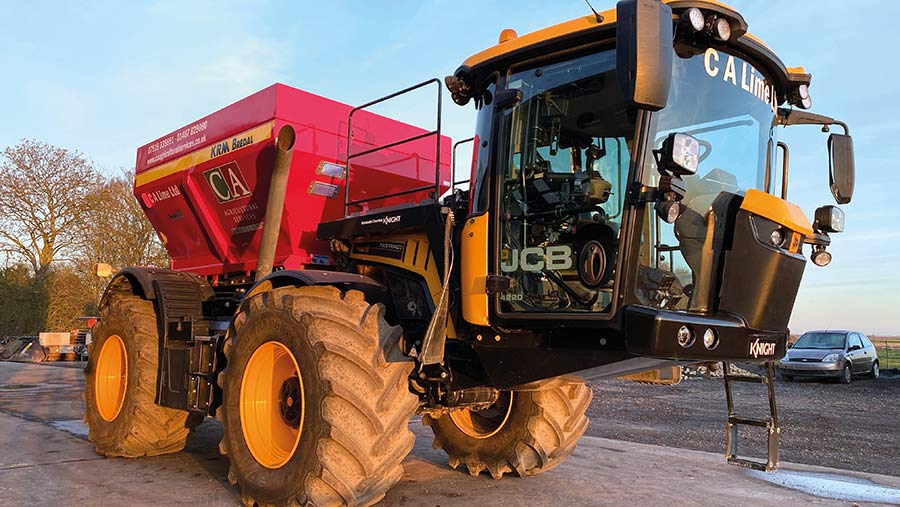
© MAG/Oliver Mark
The conversion
The Multidrive 6195 was sold to a contractor in Scotland to fund the investment in a second Fastrac and Bredal spreader.
Only this time, it was sent from Pecks’ yard straight to that of Knight Farm Machinery in Rutland, where it would have the cab repositioned ahead of the Agco Power engine and the spreader body mounted on a bespoke subframe.
It was the first spreader conversion Knight had been charged with, having previously specialised solely in the fitment of rear-platform spray packs with tank capacities up to 4,000 litres and booms to 40m.
The first element of the conversion was fairly orthodox, with Knight’s engineers moving the cab onto a chassis extension plate at the front of the tractor and using their plug-in kits for the wiring harnesses that allowed them to be routed to the front of the tractor.
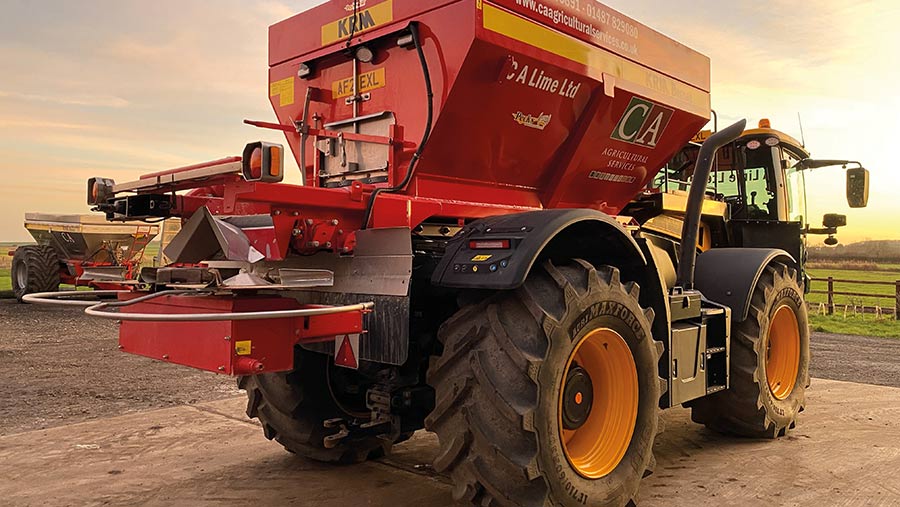
Bredal’s K65 spreader will carry up to 10t of lime when fitted with greedy boards © MAG/Oliver Mark
Other modifications included slicing off the tip of the bonnet and refitting it on the window to hide the back of the dash, and fitting a new grille assembly that allows air to flow into the radiator, despite the front of the engine bay butting up to the rear of the cab.
A platform above the bonnet provides a safe place from which to cut open fertiliser bags.
“The conversion of the tractor unit was relatively quick because Chris didn’t need to be able to fit larger row crop or flotation wheels,” says Knight’s John Wooding.
“Most of our sprayer-conversion customers need the extra ground clearance and that means making space for the wheels by altering the fuel tank and exhaust system, which doubles the time it takes to finish.”
In fact, Mr Anstey preferred to reduce the clearance – to the cab, at least – as the driver is often climbing in and out every 10 minutes to load up.
The more time-consuming element for Knight’s engineers was developing the subframe to carry the spreader body which, in the end, took the best part of four months.
Spreader body
The front of the spreader unit bolts to the original cab mounts, while the back end sits above the dissembled rear linkage.
“We opted for a shorter K65 body to fit neatly on the back of the Fastrac, and it has proved far easier to load than our longer trailed K85, as it’s roughly the width of the telehandler bucket.”
“And by fitting 30cm greedy boards, the K65 matches it for capacity – upping it from 7.5t to roughly 10t of lime, which takes between five and 10 minutes to spread.”
The system is relatively simple, with one double-acting spool controlling the drive to the conveyor belt in the base of the hopper and the Fastrac’s rear pto powering the pair of four-vane spreader discs.
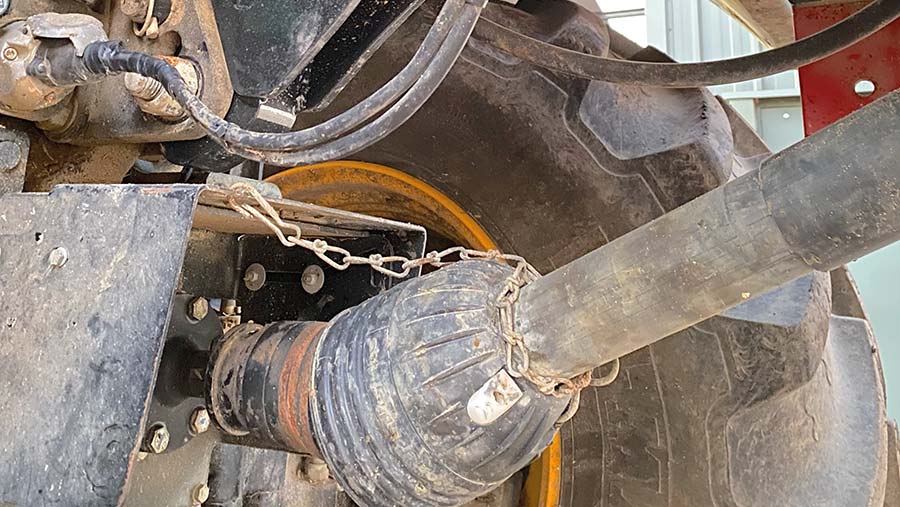
Plans are under way to add a second rear suspension element © MAG/Oliver Mark
These will throw lime to 12m and, by changing the discs, drop chutes and speeds, launch hard fertiliser products such as phosphorus and potassium to 40m.
Guidance comes via a pre-wired Trimble system with a Nav-900 dome and 10in XCN 1050 screen (the same as fitted by New Holland). This runs on the RangePoint correction signal, which provides ample accuracy for keeping the outfit running on a straight AB line.
How has it performed?
Mr Anstey has few complaints thus far, with the forward-control Fastrac performing as he hoped over its first 700 hours and 6,000 miles since delivery in July – meaning it is on course to hit his target of 1,000 hours/year.
“Efficiency in this job relies on minimising downtime, whether it be travelling to site or returning to the heap to refill. That’s where the 63kph top speed comes into its own, and it does that with the engine ticking along at 1,700rpm – compared with 50kph at 2,400rpm in the Multidrive.
“The end result is that we’ve improved daily output by 30% and diesel consumption has been reduced to about 300 litres for a 15-hour day – roughly 20 litres/hour.”
It has also proved a match for the firm’s standard 4220 in terms of comfort, despite the cab hanging awkwardly ahead of the front wheels, according to Mr Anstey’s son and full-time operator, Ryan.
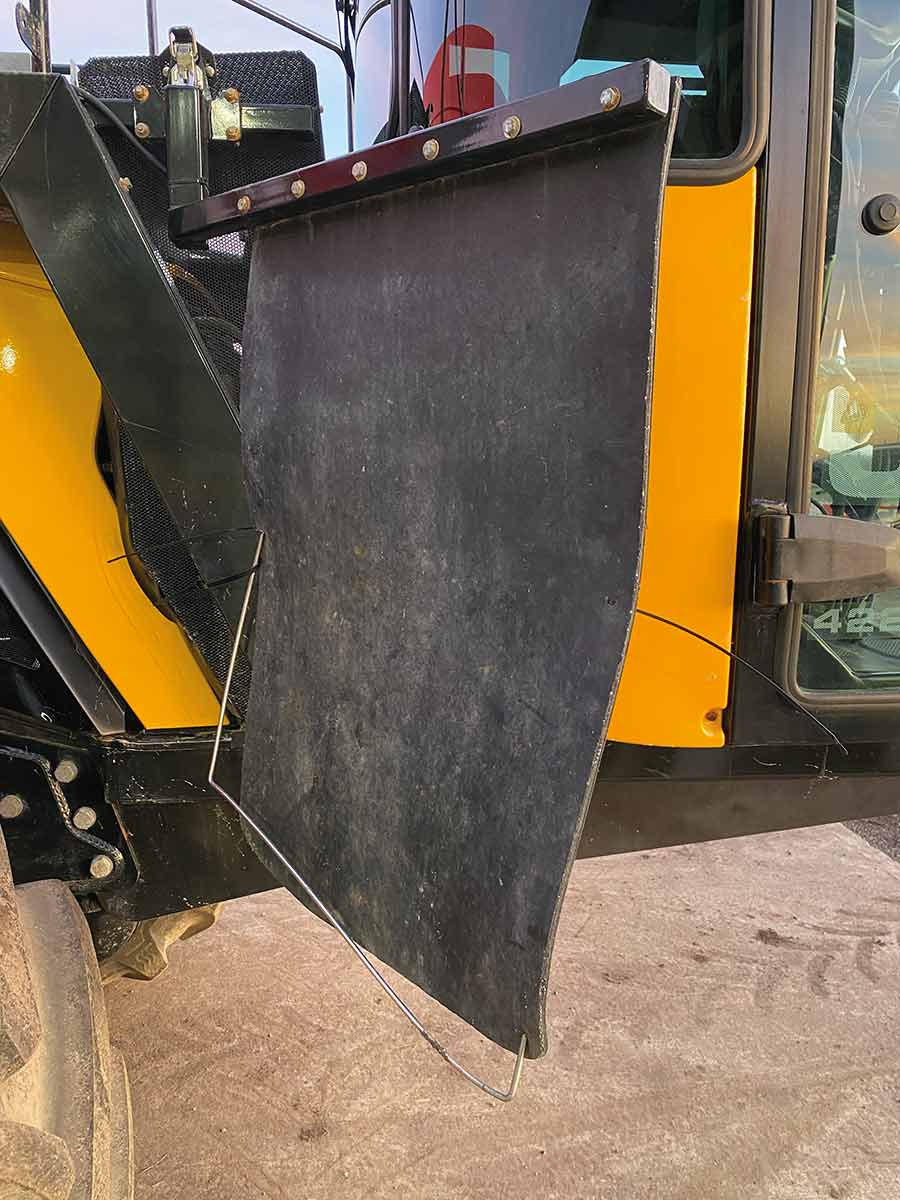
© MAG/Oliver Mark
“The cab doesn’t nod on the road and it is marginally quieter than our conventional Fastrac.
“The position of the cab also makes it far easier to see what’s going on when I’m pulling into gateways, particularly as I often have a 35ft Staines flatbed on the back – making the whole lot about 21m long.”
Mr Anstey attributes some of the comfort to his choice of BKT tyres, which, he says, had a better load rating that the equivalent Michelins and were £800/tyre cheaper.
“The Michelins were going to cost £2,000 each, but the BKT IF 710s [710/60 R30s AgriMax Force] were £1,200.
“We run them at 23psi, which seems to be a reasonable balance between what we need on the road and what is comfortable when running at 25kph in the field. I have looked at central tyre inflation systems for the back axle to give us the option of adjusting pressures on the move, but they’re too expensive.
“I’ve tried to avoid going mad on extras, because they cost money that can be hard to justify to our customers.
“Plus, the Multidrives had the full package, but most of the add-on bits, such as the weighcells, have stopped working and aren’t worth fixing, as they don’t really influence our ability to do the job.”
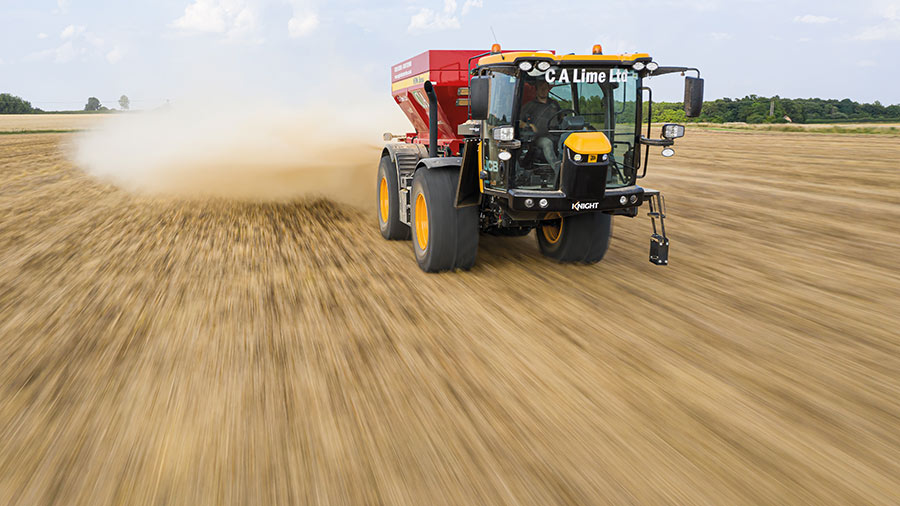
© Martin Murphy
Any changes?
JCB’s self-levelling hydro-pneumatic suspension system has proved successful, transferring the weight between the two axles and keeping the tractor level as the lime is gradually offloaded.
However, the extra suspension airbag, which Knight fitted between the top link bracket and the spreader body to cushion the weight, hasn’t quite worked as intended.
“It needs uprating because, at the minute, having a single air bag centrally between the rear wheels causes side-to-side rocking. The lip of the spreader hopper is 3.5m off the ground, so the centre of gravity is high, and it can end up leaning to one side until it’s almost empty.
“Instead, we’re going to go to two air bags – one each side of the top link bracket – to make it more stable when it’s fully loaded. It’s one of those teething problems you expect to get with a bespoke machine.”
The only other change has been to fit some rudimentary guards for the back of the cab to protect it from debris thrown forwards of the front wheels. Aside from that, Mr Anstey has been so pleased that he has ordered another forward-control 4220 for delivery early next year, which will replace the remaining Multidrive M420.4.
“I wanted to get the order in before the new 4000-series Fastracs come out. Pecks were talking about a price rise, which I could do without – the current model has everything I need.”
Bespoke app
CA Agricultural Services offers a full supply-and-apply spreading business, plus soil sampling and GPS mapping, across East Anglia and the Midlands.
Central to the business is an app Chris Anstey developed with the help of a company in Staffordshire, which allows him to record and share all the information he collects, including precise field sizes and soil conditions, while he’s in the field.
“I used to draw the fields by hand, but Google Maps is now integrated into the app, so I have all the information about my customers’ farms in my hand.
“This means I can log sample points onto the map, input application rates and send the details straight to the farmer, who can view the prescription and cost. It’s so quick and simple that I haven’t seen some of my customers in person for three years.”
Once given the thumbs-up, the map containing target application rates can be sent to the spreader operator’s iPad.
However, getting the app talking to the spreader’s rate controller has proved problematic so, instead, the drivers simply view their location on the prescription map and adjust the application rate manually.
While this doesn’t give complete automation, Mr Anstey reckons the app has still saved about three hours/day, plus customers get a more accurate application of material where it is needed.

